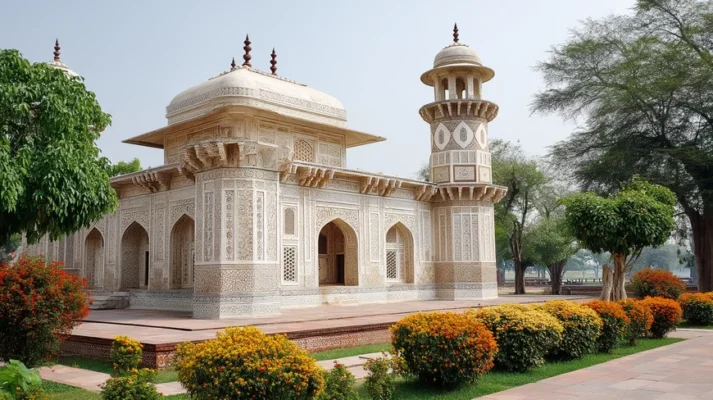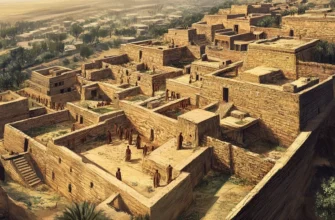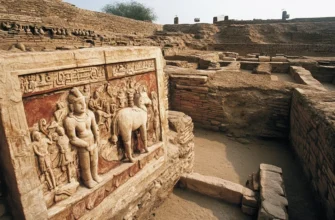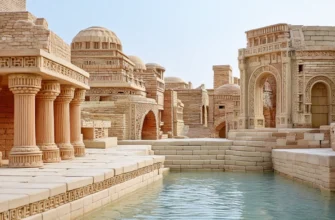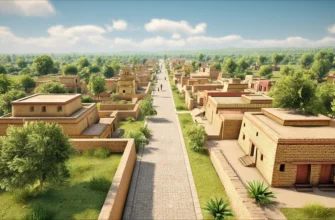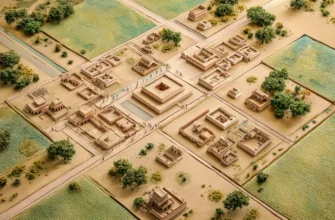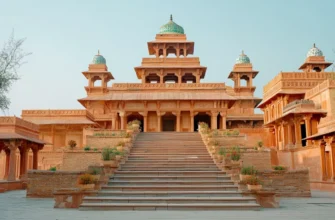Itimad-ud-Daula is a mausoleum located in Agra, India, built between 1622 and 1628. This architectural gem is one of the most significant examples of Mughal architecture and is known for its exquisite marble carvings. The mausoleum was built in honor of Itimad-Ud-Daula, a high-ranking official at the court of Emperor Jahangir, and became the first large monument built entirely of white marble.
The architectural style of the mausoleum combines Indian, Persian, and Central Asian elements to create a unique look. The mausoleum consists of a main building with four minarets located at each corner, as well as exquisite gardens symbolizing paradise.
Itimad-ud-Daulah is also significant as the prototype for the Taj Mahal. Thanks to its architectural beauty and symbolic significance, this mausoleum is an important part of India’s heritage and attracts thousands of tourists from all over the world.
The Itimad-ud-Daulah mausoleum is not only an architectural masterpiece, but also reflects the deep emotional and cultural aspects of the Mughal era, leaving an important mark on Indian history.
History of the mausoleum
The Itimad-ud-Daulah Mausoleum was built between 1622 and 1628 in Agra at the behest of his daughter, Nur Jahan, wife of Emperor Jahangir. Itimad-Ud-Daula, a high-ranking official at Jahangir’s court, was greatly respected for his loyalty and service to the emperor, and his death in 1622 was a great loss to the family.
Deeply saddened by the loss of her father, Nur Jahan decided to build a mausoleum for him, which would not only be an expression of her reverence, but also a symbol of family loyalty and greatness. The commission for the construction of the mausoleum was given to a renowned architect, who used innovative techniques and materials to create this monument.
The mausoleum was the first major project to use white marble for the main building and for decorating the facades. An important feature of the mausoleum is the combination of traditional Mughal architecture with new elements, including Persian and Central Asian motifs. The complex includes not only the mausoleum itself, but also beautiful gardens symbolizing paradise and water channels emphasizing harmony with nature.
The Itimad-ud-Daulah Mausoleum became the prototype for the more famous Taj Mahal, as the architectural solutions implemented in its construction were later used in the creation of the famous mausoleum for the wife of Emperor Shah Jahan, Mumtaz Mahal.
The Itimad-ud-Daulah mausoleum was built for several important reasons, both personal and cultural.
Respect for her father: The main reason for the creation of the mausoleum was the deep respect and love of Itimad-ud-Daulah’s daughter, Nur Jahan. She was very close to her father, and his death in 1622 left a deep mark on her life. By building this mausoleum, Nur Jahan expressed her gratitude and respect for her father, who was an important figure at the court of Emperor Jahangir.
Political and social significance: Itimad-ud-Daula was not only a loyal official but also one of the most influential people at the court of the Mughal Empire. His death left a significant gap in the political life of the empire, and the mausoleum became a symbol of his importance to the state.
Architectural experiment: The Itimad-Ud-Daula mausoleum was the first large-scale project to use white marble and intricate marble carvings, which later became a characteristic feature of the more famous Taj Mahal. It was a way to demonstrate the architectural skill and grandeur of the Mughal Empire through innovative ideas and techniques.
Religious and symbolic significance: The mausoleum was built in a style that combined Indian, Persian, and Central Asian architectural traditions, which also had symbolic significance — it reflected the fusion of cultures and religions within the Mughal Empire and symbolized eternal peace and life after death.
Thus, the Itimad-ud-Daula mausoleum became not only the resting place of a great official, but also a cultural and architectural symbol of an era, combining personal feelings and political ambitions.
Architectural features
The Itimad-ud-Daula mausoleum is an important masterpiece of Mughal architecture, combining Indian, Persian, and Central Asian elements. Its architecture is distinguished by the subtle use of marble, as well as elegant carvings and decorative elements.
Here are some of the main architectural features of this mausoleum:
Use of white marble: The mausoleum was the first large monument of the Mughal Empire to use white marble as the main building material. This gave the building an elegant and light appearance, distinguishing it from other monuments built of red sandstone.
Marble carving: One of the most striking aspects of the mausoleum’s architecture is the detailed marble carving. The carved patterns that cover the walls, doors, and other surfaces depict floral and geometric motifs that emphasize the elegance and delicacy of the architectural forms.
Persian garden design: The mausoleum is set in gardens reminiscent of Persian “four-cornered gardens” (jannat). This represents paradise, an important element in Islamic art. The garden is divided into four parts by water channels, creating a symmetrical and harmonious composition.
Four minarets: The mausoleum is surrounded by four minarets rising at the four corners of the building. This architectural solution creates a harmonious appearance and emphasizes the symmetry of the composition, which is an important element of the Mughal style.
Central building and pavilion: The central part is a white marble pavilion, which houses the tombs of Itimad-Ud-Daula and his wife. This pavilion is square in shape and covered with a dome, and its facades are decorated with intricate decorative elements such as marble panels inlaid with precious stones.
Symmetry and composition: The mausoleum is built on the principle of complete symmetry, which is characteristic of the architecture of that time. The entire building and garden elements are arranged in such a way as to create balance and harmony, symbolizing order and orderliness.
Inlay and decorative elements: In addition to marble carvings, the building is decorated with inlays of precious stones such as agate, lapis lazuli, jade, and others. These details add extra sparkle and beauty, emphasizing the elegance of the structure.
The Itimad-ud-Daulah Mausoleum is a magnificent example of the combination of aesthetics and technical mastery that became the basis for the further development of Mughal architecture and influenced the creation of the famous Taj Mahal.
Architectural style and design
The Itimad-ud-Daulah Mausoleum is an important architectural masterpiece of the Mughal Empire and the first building to be constructed entirely of white marble. Its architectural style combines elements of traditional Mughal architecture with Persian and Central Asian influences, creating a unique composition. Here are some of the main aspects of the architectural style and design of the mausoleum:
Architectural style:
Mughal style: The mausoleum was built in the tradition of Mughal architecture, which is characterized by majestic palace and temple structures that combine Persian, Indian, and Central Asian elements. This style is characterized by symmetry, huge domes, arches, and minarets.
Persian influences: The architecture of the mausoleum has many elements reminiscent of Persian garden-palace complexes, particularly in the layout of the gardens and water channels. The central pavilion with four minarets is surrounded by a garden symbolizing paradise, which is characteristic of Persian gardens.
Central Asian influences: The influence of Central Asian architectural traditions is also evident, particularly in the interior design and ornamentation.
Construction:
Layout: The Itimad-ud-Daula Mausoleum has a square plan. It is a building with four minarets located at the corners, symbolizing stability and protection. The central pavilion contains the tomb, which is located on a raised platform, surrounded by gardens divided by water channels. The water and garden compositions create an atmosphere of peace and harmony.
Materials: The mausoleum was built mainly of white marble, which makes it particularly impressive. The use of marble also gives the structure an elegant and refined appearance. In addition, the design features decorative elements made of precious stones such as agate, jade, lapis lazuli, and coral, which add a special sparkle and beauty.
Dome and arches: The main building is crowned with a dome, which is an important element of traditional Mughal architecture. The entrance to the mausoleum is decorated with large arches that emphasize the grandeur and significance of the structure.
Decorations and carvings: The marble walls are decorated with intricate carvings and inlays depicting floral motifs and geometric patterns. These decorative elements create an elegant atmosphere and impress with their details.
Symmetry and composition:
One of the main features of the mausoleum’s architecture is its perfect symmetry. The entire building and surrounding gardens are designed to maintain balance and harmony. This reflects the order and perfection of the world, which is often symbolized in Islamic art through the combination of straight and curved lines.
Interior:
The interior of the mausoleum is no less impressive. The mausoleum contains magnificent carved marble panels depicting scenes from the life of the deceased and religious motifs.
Inside the pavilion are the tombs of Itimad-Ud-Daula and his wife. They are decorated with exquisite carvings and inlays of precious stones, adding to the grandeur of the entire structure.
Thus, the architectural style and design of the Itimad-ud-Daula mausoleum impress with their symmetry, elegance, and craftsmanship, making it not only an architectural masterpiece but also an important cultural and historical symbol of the Mughal era.
Symbolism and composition
The Itimad-ud-Daula Mausoleum is not only an architectural beauty but also a work of art with deep symbolism. Every element of this structure, from the overall composition to the details, has its own symbolic meaning, reflecting the cultural and religious beliefs of the Mughal Empire.
Symbolism of the garden:
The Itimad-ud-Daula mausoleum is surrounded by a garden, which is an important symbol in Islamic architecture. Gardens in Islam often symbolize paradise or “jannah” — a place of eternal bliss attained by righteous people.
The garden in the mausoleum is not only a place of beauty, but also a metaphor for harmony and peace achieved through faith and moral purity. The water channels that divide the garden into four parts also symbolize the four rivers of paradise, a common motif in Islamic art.
Four parts:
The symmetrical layout of the mausoleum is also not accidental. The garden is divided into four quadrants, which have symbolic meaning. The four parts symbolize not only paradise, but also the four main rivers mentioned in Islamic tradition (milk, honey, wine, and water).
It can also be a metaphor for the four main principles of Islam: the testimony of faith, prayer, fasting, and almsgiving.
Symmetry as an expression of order:
Symmetry is an important feature both in the architecture of the mausoleum and in its entire design. It symbolizes the balance and order that should exist in an ideal world and in a person’s spiritual life. Symmetry is also associated with God’s perfection, because everything in the world should be in harmony, and this desire for harmony is reflected in architecture.
Dome and minarets:
The dome crowning the main part of the mausoleum is an important symbol of heaven and the divine kingdom. In Islamic art, the dome symbolizes the connection between earth and heaven and is also the embodiment of divine power.
The minarets surrounding the mausoleum can symbolize stability and spiritual elevation, and their height adds grandeur to the structure.
Use of marble and decorative elements:
The use of white marble in the construction of the mausoleum is not only an aesthetic choice but also has symbolic meaning. The color white is associated with purity, light, and eternal life. Inlays of precious stones such as agate, jade, and lapis lazuli enhance the impression of luxury and spiritual grandeur, while creating an image of eternal beauty and spiritual wealth.
The tomb of Itimad-ud-Daula as the centerpiece of the composition:
The tomb of Itimad-ud-Daula and his wife occupies the central place in the mausoleum. It is located in the center of the pavilion, embodying the idea of the importance and greatness of the deceased.
The composition of the tomb itself and its location in the center of the pavilion emphasize the role of Itimad-Ud-Daula as an outstanding personality and symbolize the respect and love that his family had for him.
The mausoleum as a prototype for the Taj Mahal:
The mausoleum of Itimad-ud-Daula is considered the prototype for the Taj Mahal. Since this mausoleum was built in honor of a great personality and represents great architectural sophistication, it set the style for the subsequent, more famous structure, the Taj Mahal, which became a symbol of love and beauty. This again emphasizes the importance of the mausoleum as an architectural and spiritual symbol.
Harmony with nature:
One of the main symbols of the mausoleum is its integration with nature. The location of the mausoleum among gardens and water channels, as well as the symmetry of all elements, reflects the idea of harmony between man and nature and the divine order. This reflects the importance of nature as part of spiritual life and the world as a whole.
Thus, every element of the composition and symbolism of the Itimad-ud-Daula mausoleum has a deep cultural and religious meaning that reflects the spiritual values and ideals of the Mughal era.
Impact on culture and architecture
The Itimad-ud-Daula mausoleum was an important milestone in the development of Mughal architecture and had a significant influence on the culture and architectural styles that emerged in the following centuries.
Its innovations and aesthetic solutions became the basis for the development of new architectural traditions and gave a significant impetus to cultural development in India and beyond.
Architectural influence on Mughal architecture:
The Itimad-ud-Daulah Mausoleum was the first major example of the use of white marble in Mughal architecture. Its structure and decorative elements, with inlays of precious stones and marble carvings, were innovative for their time.
This style, particularly the use of marble, had a significant influence on subsequent architectural designs, including the creation of the famous Taj Mahal, which is considered the most famous symbol of Indian architecture.
The birth of a new architectural style:
The Itimad-ud-Daulah Mausoleum became the prototype for the development of a new architectural direction in India, combining elements of Persian, Central Asian, and Indian architectural traditions.
This fusion became a characteristic feature of later Mughal architecture and reflected the cultural and religious diversity of the empire. Under the influence of this style, other important buildings emerged that combined the grandeur and aesthetic ideals of the Mughal Empire.
Role in the cultural development of India:
The Itimad-ud-Daulah Mausoleum became not only an important architectural landmark but also a cultural symbol. Its construction was part of a broader cultural and political program of Emperor Jahangir and his court, which included the development of art, literature, and science.
The mausoleum, in particular, became a symbol of family devotion and ancestor worship, which was an important aspect of Indian culture at the time.
Influence on the development of garden architecture:
The garden and landscape design of the mausoleum, where water and vegetation are important elements, became significant for the development of garden architecture in India. The division of gardens into four parts, with water channels, became typical of Mughal gardens, where nature symbolizes paradise and spiritual harmony. This solution was later adapted and developed in other architectural projects, notably in the Taj Mahal.
Artistic influence on decorative arts:
The decorative elements of the mausoleum, including marble carving and inlaying with precious stones, had a great influence on the art of the time. These techniques became important elements of decorative art and were later adapted for other buildings and objects, including furniture, jewelry, and other architectural elements. Inlay techniques, in particular, became one of the main features of the Mughal style in architecture and decorative arts.
Reflection of the empire’s grandeur and spirituality:
The Itimad-ud-Daulah mausoleum became a symbol of the grandeur of the Mughal Empire, which had reached its peak at that time. It demonstrates not only architectural skill but also the high cultural awareness of the time. Built in honor of an outstanding personality, the mausoleum became an expression of imperial policy, in which personality cult and family values were often combined with religious ideas.
Impact on world architecture:
Although the Itimad-ud-Daulah mausoleum is part of India’s cultural heritage, its influence can also be seen in world architecture.
Its architectural solutions, in particular the use of white marble and inlay work, were studied by other cultures and adapted in various architectural styles. This contributed to the development of more sophisticated and complex techniques in construction and design, which influenced the architecture of the Middle East, South and East Asia.
Influence on the empire’s subsequent architecture:
The Itimad-ud-Daula Mausoleum became not only an important stage in the development of Mughal architecture, but also a model for future architectural projects, in particular for the Taj Mahal. This influence can be seen not only in stylistic elements, but also in the overall concept of creating large monumental structures that combine beauty, functionality, and spiritual meaning.
Importance in preserving cultural heritage:
The Itimad-ud-Daulah Mausoleum is an important element of India’s cultural heritage, contributing to the preservation and promotion of the Mughal style in the modern world. Its architecture and design continue to inspire architects, artists, and researchers studying the history and art of the Mughal Empire.
Thus, the Itimad-ud-Daulah mausoleum has had a significant impact on the cultural and architectural development of India and the world. Its architectural solutions and decorative elements have become the basis for new achievements in architecture and art, continuing to influence subsequent generations.
The prototype of the Taj Mahal
The Itimad-ud-Daulah mausoleum, built in 1628, is considered an important prototype for the Taj Mahal, one of the world’s most famous architectural masterpieces.
Although both structures have different histories and were built at different times, there are significant similarities between them, allowing the Itimad-ud-Daulah mausoleum to be considered the prototype for the Taj Mahal.
Use of white marble:
One of the main similarities is the use of white marble in both buildings. The Itimad-ud-Daulah mausoleum was the first large structure to be built entirely of white marble. This material gives the building an elegant appearance and symbolizes purity and spiritual grandeur. Later, in the Taj Mahal, marble also became the main material used to emphasize the grandeur and beauty of this mausoleum.
Architectural style and composition:
The Itimad-ud-Daula Mausoleum is an example of the classic Mughal architectural style, which combines Persian, Central Asian, and Indian elements. The same combination of styles was used in the construction of the Taj Mahal, demonstrating similarities in compositional solutions.
Both mausoleums have a central domed building surrounded by a garden with water channels and minarets, creating a harmonious and symmetrical composition.
Symmetry and layout:
Both mausoleums have a clear symmetrical layout. The garden around the Itimad-ud-Daulah mausoleum is divided into four parts by water channels, which is a traditional element in Mughal architecture and symbolizes the Garden of Eden. The Taj Mahal also has a similar composition with clearly divided parts of the garden and water channels symbolizing the rivers of paradise.
Inlay and decorative elements:
The Itimad-ud-Daulah mausoleum is the first building to use intricate marble inlay techniques with precious stones such as agate, jade, and lapis lazuli.
This exquisite art of decorative decoration also became a characteristic feature of the Taj Mahal, where marble inlay with precious stones is even more refined.
The significance of the mausoleum as a symbol of love and reverence:
The Itimad-ud-Daulah mausoleum was built in memory of a great statesman and was designed as a symbol of respect for him by his daughter, Nur Jahan.
While the Taj Mahal is a symbol of deep love and mourning for the deceased wife Mumtaz Mahal, both structures are expressions of grandeur and honor to the memory of important personalities.
Approach to garden design:
Both mausoleums have garden compositions symbolizing paradise. The Itimad-ud-Daulah garden, divided into four parts, is a direct prototype for the Taj Mahal, where the division of the garden also has a symbolic meaning related to Islamic ideas of paradise.
Role in the development of Mughal architecture:
The Itimad-ud-Daulah mausoleum was an important milestone in the development of Mughal architecture, paving the way for the creation of the Taj Mahal. The architectural solutions used in the Itimad-ud-Daula mausoleum became the basis for the development of the more ambitious Taj Mahal project, particularly in terms of planning, use of materials, and decorative elements.
Landscaping solutions:
Itimad-Ud-Daula was an important step in the development of garden architecture in the Mughal Empire. The garden surrounding the mausoleum has a clear layout with four canals symbolizing the rivers of paradise. The Taj Mahal has a similar garden structure, which again emphasizes the connection between the two structures.
Influence on later architecture:
The architectural solutions used in the Itimad-Ud-Daula mausoleum had a significant influence on subsequent buildings in India, particularly the Taj Mahal.
The principles of symmetry, the use of marble, inlaying with precious stones, and garden compositions were adapted to a new context to create one of the world’s most famous architectural masterpieces.
Thus, the Itimad-ud-Daulah mausoleum can be considered the direct prototype for the Taj Mahal. It established the architectural and decorative principles that were later refined in the Taj Mahal, becoming its foundation from both an architectural and symbolic point of view.
Tourism and the current state of the mausoleum
The Itimad-ud-Daulah Mausoleum, located in the city of Agra, is an important tourist attraction in India, attracting numerous tourists from all over the world due to its architectural and historical value.
Its grandeur and architectural features make it a popular place to visit, and its importance to the development of Indian architecture enhances its cultural value. The mausoleum is often referred to as the “Little Taj Mahal” and is an important element for those interested in the history of the Mughal Empire.
Today, the mausoleum is protected by the Indian government, and numerous restoration works have been carried out over the past decades to preserve its architectural integrity. Thanks to the restorations, the structure of the mausoleum has retained its elegance and exquisite inlay work. However, as with many other ancient buildings, wear and tear on the materials requires periodic repairs to keep the monument in good condition. In particular, work to restore the inlays and decorative elements is important to maintain the appearance of the mausoleum.
Tourism in the region is also actively developing thanks to the popularity of the mausoleum among tourists, who often include it in their itinerary along with other historical sites in Agra, such as the Taj Mahal. The mausoleum is becoming a place not only for viewing architectural monuments, but also for studying the history and culture of India. The tourist infrastructure around the mausoleum includes hotels, restaurants, and transportation services that contribute to a comfortable stay for visitors.
Due to the growth in tourist traffic, important measures are being taken to ensure proper care and protection from possible wear and tear due to human impact. To this end, restrictions are being imposed on visitors’ proximity to the walls of the mausoleum, allowing the inlay and architectural details to be preserved. In addition, restoration projects aimed at preserving the marble and precious stones are necessary to prolong the life of this architectural monument.
The Itimad-Ud-Daula Mausoleum is of great importance to India’s cultural heritage, and tourism contributes to its preservation and the financing of restoration work. However, it remains less well known than the Taj Mahal, but with growing interest in cultural heritage, it is attracting more and more visitors. The main challenges are securing adequate funding for the preservation of the monument and giving the necessary attention to preserving its architectural integrity to ensure its future for future generations.
Conservation issues
The conservation of the Itimad-ud-Daulah mausoleum faces several serious challenges arising from the age of the building, changes in the surrounding environment, and the impact of human activity. Since the mausoleum was built more than 400 years ago, its materials, particularly marble and precious stones, are subject to erosion, requiring constant maintenance and restoration work.
One of the main problems is the natural wear and tear of the marble and inlays, which constitute the main architectural value of the structure. Since the mausoleum is located in an area with high humidity and air pollution, this negatively affects the condition of the materials, leading to their gradual destruction. Dust, smog, and other harmful emissions accelerate the oxidation and corrosion of marble and cause darkening of surfaces.
Another serious problem is the flow of tourists. Every year, thousands of tourists visit the mausoleum, and although most of them follow the rules of conduct, the constant load on the object can lead to mechanical damage. The proximity of visitors to the walls and details of the inlays can cause damage that is difficult to repair.
Climate change may also cause additional difficulties in preserving the mausoleum. Temperature fluctuations, changes in water levels, and other natural disasters can cause cracks in the building and destabilize it. The Indian government and various organizations carry out regular restoration work, but these problems require constant attention and significant financial investment.
Overall, comprehensive measures are needed to effectively preserve the mausoleum, including restoration, restricting tourist access to certain parts of the structure, and controlling environmental influences to preserve this important architectural masterpiece for future generations.
Conclusions
The Itimad-ud-Daula Mausoleum occupies an important place in the history and culture of India. It is a symbol of the greatness of the Mughal Empire and the first significant example of the use of white marble in the construction of mausoleums, which later became a characteristic feature of many Mughal architectural structures.
It is not just a burial place, but also an architectural masterpiece that reflects the evolution of the art of inlaying, the use of precious stones and marble, and the combination of Persian and Indian architectural traditions.
Itimad-Ud-Daula had a great influence on the development of Indian architecture. Its construction became a prototype for later monuments, including the famous Taj Mahal, and demonstrated new possibilities for the use of materials and architectural techniques. Symmetry, composition, and intricate inlay work became the main characteristics of Indian architecture at that time.
In conclusion, the Itimad-ud-Daulah mausoleum had a significant impact on India’s cultural and architectural heritage, leaving a deep mark on art history that continues to inspire architects and historians to this day. It is an important symbol of the power and beauty of the Mughal era, retaining its significance as a cultural and historical site for future generations.
